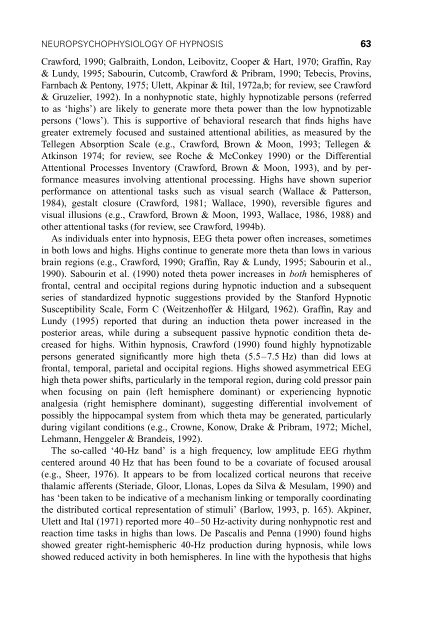International Handbook of Clinical Hypnosis - E-Lib FK UWKS
International Handbook of Clinical Hypnosis - E-Lib FK UWKS
International Handbook of Clinical Hypnosis - E-Lib FK UWKS
You also want an ePaper? Increase the reach of your titles
YUMPU automatically turns print PDFs into web optimized ePapers that Google loves.
NEUROPSYCHOPHYSIOLOGY OF HYPNOSIS 63<br />
Crawford, 1990; Galbraith, London, Leibovitz, Cooper & Hart, 1970; Graf®n, Ray<br />
& Lundy, 1995; Sabourin, Cutcomb, Crawford & Pribram, 1990; Tebecis, Provins,<br />
Farnbach & Pentony, 1975; Ulett, Akpinar & Itil, 1972a,b; for review, see Crawford<br />
& Gruzelier, 1992).In a nonhypnotic state, highly hypnotizable persons referred<br />
to as `highs') are likely to generate more theta power than the low hypnotizable<br />
persons `lows').This is supportive <strong>of</strong> behavioral research that ®nds highs have<br />
greater extremely focused and sustained attentional abilities, as measured by the<br />
Tellegen Absorption Scale e.g., Crawford, Brown & Moon, 1993; Tellegen &<br />
Atkinson 1974; for review, see Roche & McConkey 1990) or the Differential<br />
Attentional Processes Inventory Crawford, Brown & Moon, 1993), and by performance<br />
measures involving attentional processing.Highs have shown superior<br />
performance on attentional tasks such as visual search Wallace & Patterson,<br />
1984), gestalt closure Crawford, 1981; Wallace, 1990), reversible ®gures and<br />
visual illusions e.g., Crawford, Brown & Moon, 1993, Wallace, 1986, 1988) and<br />
other attentional tasks for review, see Crawford, 1994b).<br />
As individuals enter into hypnosis, EEG theta power <strong>of</strong>ten increases, sometimes<br />
in both lows and highs.Highs continue to generate more theta than lows in various<br />
brain regions e.g., Crawford, 1990; Graf®n, Ray & Lundy, 1995; Sabourin et al.,<br />
1990).Sabourin et al.1990) noted theta power increases in both hemispheres <strong>of</strong><br />
frontal, central and occipital regions during hypnotic induction and a subsequent<br />
series <strong>of</strong> standardized hypnotic suggestions provided by the Stanford Hypnotic<br />
Susceptibility Scale, Form C Weitzenh<strong>of</strong>fer & Hilgard, 1962).Graf®n, Ray and<br />
Lundy 1995) reported that during an induction theta power increased in the<br />
posterior areas, while during a subsequent passive hypnotic condition theta decreased<br />
for highs.Within hypnosis, Crawford 1990) found highly hypnotizable<br />
persons generated signi®cantly more high theta 5.5±7.5 Hz) than did lows at<br />
frontal, temporal, parietal and occipital regions.Highs showed asymmetrical EEG<br />
high theta power shifts, particularly in the temporal region, during cold pressor pain<br />
when focusing on pain left hemisphere dominant) or experiencing hypnotic<br />
analgesia right hemisphere dominant), suggesting differential involvement <strong>of</strong><br />
possibly the hippocampal system from which theta may be generated, particularly<br />
during vigilant conditions e.g., Crowne, Konow, Drake & Pribram, 1972; Michel,<br />
Lehmann, Henggeler & Brandeis, 1992).<br />
The so-called `40-Hz band' is a high frequency, low amplitude EEG rhythm<br />
centered around 40 Hz that has been found to be a covariate <strong>of</strong> focused arousal<br />
e.g., Sheer, 1976). It appears to be from localized cortical neurons that receive<br />
thalamic afferents Steriade, Gloor, Llonas, Lopes da Silva & Mesulam, 1990) and<br />
has `been taken to be indicative <strong>of</strong> a mechanism linking or temporally coordinating<br />
the distributed cortical representation <strong>of</strong> stimuli' Barlow, 1993, p.165).Akpiner,<br />
Ulett and Ital 1971) reported more 40±50 Hz-activity during nonhypnotic rest and<br />
reaction time tasks in highs than lows.De Pascalis and Penna 1990) found highs<br />
showed greater right-hemispheric 40-Hz production during hypnosis, while lows<br />
showed reduced activity in both hemispheres.In line with the hypothesis that highs











![SISTEM SENSORY [Compatibility Mode].pdf](https://img.yumpu.com/20667975/1/190x245/sistem-sensory-compatibility-modepdf.jpg?quality=85)





